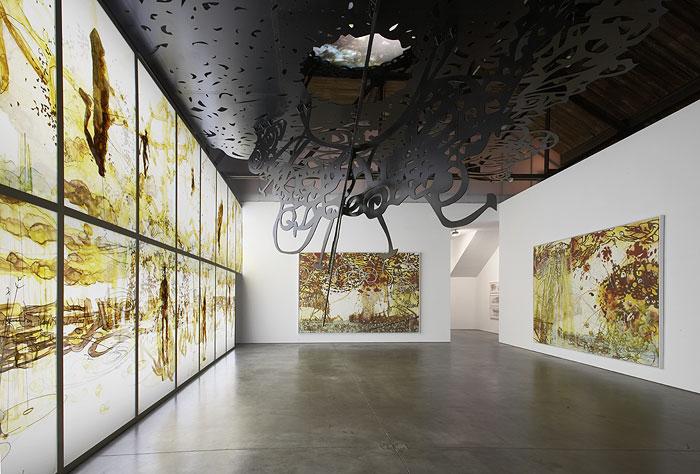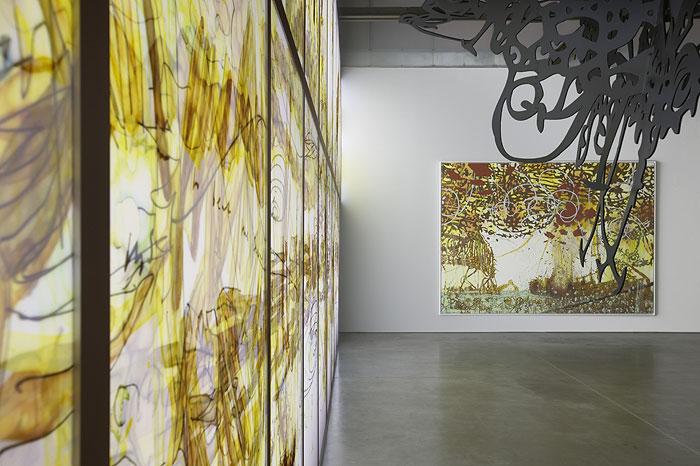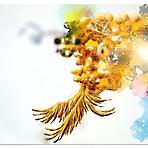Matthew Ritchie
"The Universal Adversary"
September 21 – October 28, 2006
Main Gallery
-

"The Universal Adversary"
Andrea Rosen Gallery, NY
September 21-October 28, 2006
© Matthew Ritchie
Photo by Tom Powell -

"The Universal Adversary"
Andrea Rosen Gallery, NY
September 21-October 28, 2006
© Matthew Ritchie
Photo by Tom Powell -

"The Universal Adversary"
Andrea Rosen Gallery, NY
September 21-October 28, 2006
© Matthew Ritchie
Photo by Tom Powell
Matthew Ritchie
"The Universal Adversary"
September 21 - October 28, 2006
"Their appearance and their work was as if a wheel within a wheel; as for their rings, they were so high they were dreadful and their rings were full of eyes, round about them four. And when the living creatures went, the wheels went with them for the spirit of the living creature was in the wheels." Ezekiel I: XVI-XX
This fall Andrea Rosen Gallery is excited to present "The Universal Adversary", the first New York solo exhibition of work by Matthew Ritchie in four years and the first exhibition in the gallery's redesigned space. A major architectural intervention, a folded black latticework sky almost 30 feet across, floats at the literal and conceptual center of the exhibition. The folded sky fills the main gallery, bifurcating the space into a floating viewing platform and a dense netherworld filled with new paintings. The two levels are connected by a rapturous two-story, 40-foot long wall of illuminated images, depicting evanescent figures rising into a sulfurous sky. Adventurous viewers can ascend to the second level and walk out to an oculus at the core of a suspended sphere where a projection of a parallel world, a vision of a possible future, unfolds its story.
Not one of us truly knew whose invisible hands shaped and steered them, who keeled and captained their ship. With what glass and devil. What I'm saying is; not one of us, even those who believed they were true, could read that kind of weather. Coffin weather.
While "The Universal Adversary" is the first exhibition of this magnitude in the gallery, Ritchie has been working on an architectural scale for the last five years, beginning with Games of Chance And Skill in 2002, a permanent installation created for MIT, and to be followed this summer by Stare Decisis, a GSA-commissioned installation for a new Federal Courthouse in Oregon, designed in conversation with Pritzker prize-winning architect Thom Mayne. Recently Ritchie has been collaborating with NY based architect Philip Wu on a permanent commission for CACI, Brazil, as well as London-based architect David Adjaye on a temporary pavilion that will contain an interactive performance space designed by the artist. Uniting all these projects is an interest in the question of how to create a space that is simultaneously a form of information.
Competing versions of reality are still being debated. The holographic principle proposes that volume itself is somehow illusory: that mass occupies area, not volume, and so the universe is really a hologram, isomorphic to the information "inscribed" on its boundaries. In other words, our universe is a picture and we are constantly creating it, minute by minute.
For his September exhibition in New York, Ritchie's works evoke an atmosphere of indeterminate crisis, precipitated around an entity called The Universal Adversary, a shadowy character who seems to have been conjured from our collective past to imperil our immediate future.
In 2005, the United States Government classified fifteen scenarios as major threats to the US population. Collectively these are known as the Universal Adversary. Nowhere in this list are the known causes of major threats to human life of income disparity, endemic disease, resource depletion, or radical climate change.
"We're an empire now, and when we act, we create our own reality. And while you're studying that reality - we'll act again, creating other new realities, which you can study too." G.W. Bush Administration
Acclaimed for his ambitious and influential installations of painting, drawing, lightboxes, sculpture, and projections, Ritchie's wide-ranging study of both the factual and the fictional is a defining characteristic of his work. He is especially unusual in the depth of his involvement with multiple fields of investigation. As is typical for the artist, for his exhibition We Want To See Some Light at Portikus, Frankfurt, in 2005, he collaborated with a visual neurologist, an architect, a group of students and a philosopher to examine the physical limits of generated knowledge. The British-born artist has delivered a series of lectures in forums as diverse as the prestigious 2005 Einstein Centennial Conference in Berlin, The Believer magazine's recent "literary variety show" for American PEN moderated by John Hodgman, and the Whitney Museum's conference on the work of Robert Smithson. In 2001, Time magazine included Ritchie in its list of 100 innovators of the new millennium, naming him as a person exploring "the unthinkable or the not-yet-thought."
Despite our best efforts, we cannot identify 95% of the material in the universe. In particular a missing substance dubbed 'Cold Dark Matter' is required to explain the existence of the physical structure of reality. Determining the nature of this missing mass is one of the most fundamental problems in modern cosmology.
More omnivorous than omnipotent, encompassing everything from cutting-edge physics, ancient myth, economic theory, neo-noir short stories and medieval alchemy to contemporary politics, Ritchie's installations are based equally on an internally consistent fictional ecology and the constantly changing factual understanding of our universe. The Universal Adversary and the Holographic Principle; like Ezekiel's apocalyptic visions and Dark Matter, are all metaphors for the idea of the unknowable; which is always stranger and more challenging than we can imagine. This exhibition, with pictures folded into places and stories wrapped inside projections, asks us to engage with the extraordinary truth that we are all generating our own temporary realities, our own universal adversaries.
Matthew Ritchie was born in 1964; he lives and works in New York City. Since his last exhibition in New York, he has been included in group exhibitions worldwide including: "Remote Viewing" at the Whitney Museum of American Art in 2005, the Sao Paulo Bienal XXVI & the inaugural exhibition of the 21st Century Museum of Modern Art in Kanazawa in 2004, and the 2002 Sydney Biennial. His recent solo exhibition "Proposition Player," organized by the Contemporary Arts Museum, Houston, traveled to MASS MoCA and The Fabric Workshop and Museum in 2005. Major Installation works by Ritchie will be on view through 2006 in both "Radar," the inaugural exhibition of the Denver Art Museum and "The Guggenheim" at the Kunstmuseum Bonn. The gallery opening will coincide with the publication of Matthew Ritchie: Incomplete Projects 01-07, an artist's book produced in collaboration with Purtill Family Business. A three-dimensional artist's book is in development with Rizzoli and is planned for release in 2007.
Matthew Ritchie
Published in conjunction with the project Matthew Ritchie: Remanence, an interdisciplinary 18-month artist residency from 2013 to 2014, organized by Jenelle Porter, Mannion Family Senior Curator, with John Andress, Associate Director of Performing Arts, and Gabrielle Wyrick, Associate Director of Education.
Matthew Ritchie: More Than The Eye
Acclaimed in the art world for his room-size installations of paintings, sculpture, and digital projections, Matthew Ritchie’s work investigates architecture and the dynamics of culture. Named by Time magazine in 2001 as one of 100 innovators for the new millennium, his rich work draws from subjects as diverse as ancient myth and medieval alchemy to cutting-edge physics and contemporary politics. This artist-designed book will explore Ritchie’s large-scale artistic "interventions" in buildings designed by Morphosis among others, including the Guggenheim Museum and MIT.
Publisher: Rizzoli (November 25, 2008)
ISBN-10: 0847831086
ISBN-13: 978-0847831081
Matthew Ritchie: The Morning Line
Published by Moderne Kunst Nürnberg
Edited Eva Ebersberger, Daniela Zyman. Preface by Francesca von Habsburg.
Text by Benjamin Aranda, Brandon LaBelle, Helene Furján, Chris Lasch, Tony Myatt, Hans Ulrich Obrist, Matthew Ritchie, Roland Schöny, Mark Wasiuta.
Situated at the interaction of art, architecture, music, mathematics, cosmology and science, Matthew Ritchie's "The Morning Line" is a 33-foot high sound pavilion, constructed in aluminum and conceived in part as a successor to Edgard Varèse and Le Corbusier's pavilion for the 1958 World's Fair, and Fritz Bornemann's Expo '70 Pavilion. Designed in collaboration with New York-based architects Aranda Lasch, the Arup Advanced Geometry Unit and the Music Research Centre of York University, the structure was inspired by the cosmological theories of Paul Steinhardt and Neil Turok, and offered a sonic environment in which newly commissioned works by well-known musicians were performed. This survey of the project includes a book containing Todd Eberle's photographs of the structure, a poster, a newspaper and a red vinyl LP with music by contemporary electronica musicians such as Alexej Borisov, Tommi Grönlund, Petteri Nisunen, Christian Fennesz, Carsten Nicolai, Zsolt Olejnik, Finnbogi Petursson, Franz Pomassl, Terre Thaemlitz and Zavoloka.
Publisher: Moderne Kunst Nürnberg; Box edition (April 30, 2012)
ISBN-10: 3869842423
ISBN-13: 978-3869842424
The Morning Line
Edited by Eva Ebersberger, Daniela Zyman.
Text by Caroline A. Jones, Peter Weibel, Benjamin Aranda, Chris Lasch, Mark Wasiuta, Bryce Dessner, Florian Hecker, Tony Myatt.
Extensive documentation of the worlds first traveling semasiographic structure; a collaborative environment conceived by Matthew Ritchie and designed with architects Aranda/Lasch, musician Bryce Dessner and scientist Paul Steinhardt.
Publisher: Walther Konig (February 1, 2009)
ISBN-10: 3865605664
ISBN-13: 978-3865605665
Matthew Ritchie: Proposition Player
In 1995, British artist Matthew Ritchie embarked on an extraordinary undertaking: he set out to tell the story of everything, from the Big Bang onward. His tale was to be told in paintings and drawings through a core group of 49 characters drawn from sources as diverse as mythology, quantum physics, alchemy, gambling, biblical tales, and pulp fiction. With Proposition Player, Ritchie's first major solo museum exhibition and accompanying catalogue, his narrative has reached a "climax, collapse, and crisis"--the story has morphed into a game and Ritchie has created a veritable information casino. Accompanying the paintings and drawings for which the artist is internationally known are works in new media, including a 100-foot-long three-dimensional drawing, an interactive craps table with digital animation that invites viewers to roll the dice for the future of the universe, an enormous rubble floor mosaic that invites viewers to walk into the heart of the piece, and a deck of cards featuring Ritchie's cast of characters.
Publisher: Contemporary Arts Museum (January 31, 2004)
ISBN-10: 0936080841
ISBN-13: 978-0936080840
Matthew Ritchie: Incomplete Projects 01-07
Matthew Ritchie: Incomplete Projects 01-07 was originally published from 2000 to 2006 as seven separate volumes to record a diverse group of projects. Institutional acknowledgements and credits accompanied each volume. Half of each print run was preserved to be collected in this final edition.
Awards: Best of Category in Graphic Design, I.D. Magazine, 2007
Hardcover: 224 pages
Publisher: Wild Card Crew, in collaboration with the Museum of Contemporary Art, North Miami; Dallas Museum of Art; Artists Space; MIT; Parkett; Two Palms Press; and Portikus
Matthew Ritchie: Incomplete Projects 07
Catalogue published in conjunction with the exhibition "We Want to See Some Light," July 9 - August 21, 2005, at Portikus im Leinwandhaus, Frankfurt am Main. It is the seventh volume in a multi-part series titled Matthew Ritchie, Incomplete Projects.
Matthew Ritchie: Incomplete Projects 06
Published in conjunction with Two Palms Press, 2004. It is the sixth volume in a multi-part series titled Matthew Ritchie, Incomplete Projects.
Matthew Ritchie: Incomplete Projects 05
Catalogue published in conjunction with the permanent installation Games of Chance and Skill (2002), commissioned by the MIT Perecent for Art Program for the Albert and Barrie Zesiger Sports and Fitness Center on the Massachusetts Institute of Technology campus in Cambridge, Massachusetts. It is the fifth volume in a multi-part series titled Matthew Ritchie, Incomplete Projects.
Matthew Ritchie: Incomplete Projects 04
Catalogue published in conjunction with the Edition for Parkett 61, November 5, 2001:
MATTHEW RITCHIE
The Bad Need
2001
adhesive-backed vinyl and acrylic paint
36 x 41 inches (92.08 x 105.41 cm)
Edition of XVIII
Accompanied by a certificate of authenticity in the form of a signed and numbered artist's book.
Matthew Ritchie: Incomplete Projects 03
Catalogue published in conjunction with the Edition for Artists Space:
MATTHEW RITCHIE
Sea State One
2001
Four color hand printed, pigminted relief print on Somerset paper.
16 x 32 inches
(40.6 x 81.3 cm)
Edition of 70
Published by Two Palms Press
Accompanied by one copy of the artist's book Sea State One: Incomplete Projects 03, containing manipulated images from The New Place, 2001, commissioned for "010101: Art in Technological Times," by the San Francisco Museum of Modern Art, CA.
Matthew Ritchie: Incomplete Projects 02
Catalogue published for the exhibition "Concentrations 38: Matthew Ritchie," organized by the Dallas Museum of Art, and curated by Suzanne Weaver, January 23 - April 21, 2001. It is the second volume in a multi-part series titled Matthew Ritchie, Incomplete Projects.
Matthew Ritchie: Incomplete Projects 01
Catalogue published for the exhibition "Matthew Ritchie," organized by the Museum of Contemporary Art, North Miami, and curated by Bonnie Clearwater, March 31 - June 25, 2000. It is the first volume in a multi-part series titled Matthew Ritchie, Incomplete Projects.
The Father Costume
Behold a stunning world, composed largely of water, where clothing changes people's behavior and time itself can be worn and discarded like cloth. Witness a father who takes his two boys out to sea, in flight from some menace at home, thus launching their adventures in a strange and dangerous territory. Artist Matthew Ritchie's striking images blend scientific diagramming with vivid, colorful renderings of the apocalypse, while writer Ben Marcus's cold prose plumbs the inner workings of two boys caught out at sea with a father whose costumes grow increasingly menacing. In this collaborative work, Ritchie's and Marcus's shared obsessions of mythology, physics and ancient texts have produced a conjunction of text and image in which people themselves are merely costumes for the darker needs that drive them.
Published by Artspace Books
Hardcover, 6.25 x 8.25 in. / 90 pgs / 16 color
Publication date 5/2/2002
ISBN 9781891273032
Matthew Ritchie: The Big Story
Published on the occassion of the exhibition "Mythopoeia: Projects by Matthew Barney, Luca Buvoli and Matthew Ritchie," curated by Jill Snyder. Presented at the Cleveland Center for Contemporary Art, Cleveland, Ohio, February 12 - May 2, 1999.
Matthew Ritchie: Hard Way
Published in 1996 by Galerie Météo, Paris, Basilico Fine Arts, New York, and C/O - Atle Gerhardsen, Oslo

















